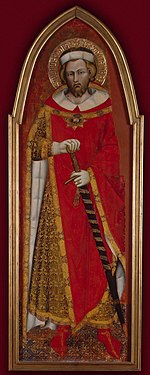Pontianus (martyr)
| Saint Pontianus | |
|---|---|

|
|
| Martyr | |
| Born | c. 156 |
| Died | 14 January 175 Spoleto, Italy, Roman Empire |
| Venerated in |
Roman Catholic Church (Spoleto, Italy; and Utrecht, Netherlands) Old Catholic Church Eastern Orthodox Church |
| Canonized | pre-congregation |
| Major shrine | Basilica of San Ponziano, Spoleto, Italy |
| Feast | 19 January (14 January in Spoleto) |
| Attributes | young man holding a sword |
| Patronage | Spoleto, Italy, and Utrecht, Netherlands |
Pontianus (Latin: Pontianus, Italian: Ponziano) (alternatively anglicized as Pontian) was a second century Christian martyr. He was martyred during the reign of the Emperor Marcus Aurelius. He is honored as a saint and martyr by the Catholic Church, the Old Catholic Church, and the Eastern Orthodox Church. In Spoleto, Italy, he is invoked for protection against earthquakes.
According to a Passio preserved in the Cathedral of Spoleto, Pontianus was a young man from a local noble family of Spoleto, 18 years of age, who had been denounced as a Christian to the Roman authorities. Brought before a judge named Flavian, he chose torture and death rather than renounce his faith. He was condemned to death and beheaded on 14 January 175.
Pontianus' body was buried in the local cemetery, called di Sincleta, outside the city walls. The Basilica of San Ponziano was eventually built over his grave as a shrine to his memory. He has become the patron saint of that city. A monastery was built attached to the basilica for a community of Bendictine monks to administer it. Over the centuries, the monks were replaced by nuns of the same order. The monastery was suppressed in 1810 during the occupation of Italy by Napoleonic forces.
Every year a festival is held in the city to honor Pontianus, its patron. Various services are held starting on the eve of the feast, which culminate in a procession through the streets of the city. Pontianus' skull, preserved in the basilica, is processed for veneration by the people of the city.
...
Wikipedia
